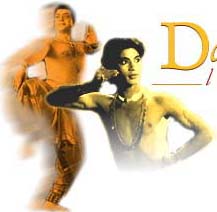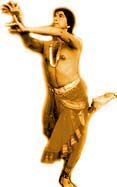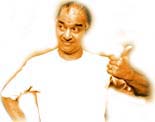

Archana Masih
If Abhay Sharma had continued with his favourite vocation, his would have been a different world. But he was forced to give it all up. After all men could not live by dance alone! And what was the need? There were enough graceful, beautiful women who bore the mantle of Indian classical dance with such élan.
Sure they did. But so did Gopi Krishna, Birju Maharaj and Kelucharan Mahapatra. Names that have remained timeless. Yet, beyond them, other famous names are not easy to come by. In a land abounding in various classical dance forms and, despite of some towering luminaries, it hasn't been easy for men to break into this female bastion.
"There are limited roles that a male dancer can perform. To add to that, the audience likes female performers," says 26-year-old Raul D'Souza (top). A trained Bharatanatyam dancer, D'Souza started with solo shows on Christian themes and branched into performances depicting the roles of Krishna and Vishnu, amongst others.
 Father Francis Barboza |
"My guru has trained me never to dance effeminately. So my movements are stern, yet graceful," he explains. D'Souza, who started learning dance when he was only five, is confident, yet many male dancers find themselves a subject of societal sniggers. Though male exponents have become more visible, the stigma still lingers. Their passion for dance, for them as reverent as religion, is often seen as seeking solace in the traditional profession of devdasis.
"Being effeminate can be true to a certain extent, but you can dance like a male and yet do a female dance. Dancer Gary Hart singularly does the roles of Ram, Sita and Ravana. It is not necessarily directly linked," says Father Francis Barboza, who is also D'Souza's guru. But he does agree that there are a lot of prejudices and wrong ideas about male dancers. Some dancers also feel their feminine delicacy comes from being taught in classes dominated by female students.
"People say we talk, walk like women," says Deepak Mazumdar, "But they misinterpret the grace in our gestures. Men can be more graceful than female dancers. Isn't the peacock more graceful than a peahen?" In his mid-thirties, Mazumdar taught Bharatanatyam for eight years after graduating from the Nalanda dance school in Bombay. Stressing on the fact that men should not forget their identity, he gives eloquent references to the robustness of Natraja and the power of Krishna's dance.
 Deepak Mazumdar |
Mazumdar's dejection is compounded by a recent incident. A leading dance critic refused to include Mazumdar's name in his book on classical dancers because 'he was too fat to be a dancer!' "He was basing his judgement on pictures that were taken earlier. I was fat then, but I had lost 10 kg around the time the book was published."
Agreeing that dance needed youthful zest, he thinks it is unfair when older female dancers give pictures taken years ago to look younger in their brochures. Much as he respects the doyens of the classical dance form in India, Mazumdar believes seniors should ensure that younger dancers are given an opportunity to make their mark.
Leading Bharatanatyam dancer and one of the pioneers of Indian classical dance, Dhananjayan agrees it is difficult for male dancers to get performances. However, he says, the last two decades have seen a change of attitude. "Much of this is because of the work done by Rukmini Devi Arundale and Kalakshetra. It was she who insisted that male dancers should dance as males and dance vigorously," says Dhananjayan, who teams with his wife Shanta to form the famed Dhananjayan duo.
Dhananjayan himself came to Kalakshetra from a small village in Kerala. On the premise that all dance forms in olden times were male-oriented and females entered only later, he feels more men are getting drawn to classical dance because of the various lecture demonstrations.
 Dhananjayan |
Against the odds, the Dhananjayans' dance troupe has been successful. Jungle Book, their dance drama, recently won much acclaim both in India and abroad. C V Chandrashekhar, former professor of dance at the Banaras University and the M S University, Baroda, attributes much of the success of male dancers to ballets and other group dances. "Unlike the past when only solo dancers performed, group dances have encouraged male dancers. Monetarily also, it is a lot better," says the veteran, who has pursued dance for the past 50 years.
Professor Chandrashekhar, however, condemns the unfair treatment meted out to male dancers by the dance sabhas. "In a 15 day festival, sabhas give maybe one day to a male dancer, while females dance on all the other 14 days," he says. To encourage male dancers, he teaches poor boys without any remuneration, and has witnessed an increase in the number of male dancers over the last 25 years.
His experience reveals that affluent families don't send their boys for dancing, which broadly is a worldwide phenomenon. "Although boys work much harder to establish themselves," continues Professor Chandrashekhar, "a kind of stigma is attached until you attain fame and money."
 Vijay Madhavan |
Winner of the Indian Fine Arts Society Best Dancer award last year, Madhavan says, "I must say they are not exactly male dancers but couple dancers. They should get a chance to come on their own, not with the help of their wives. Now most of the male dancers are getting married to a nice girl in order to continue dancing."
A postgraduate student of molecular biology, Madhavan has a very realistic approach. Confessing that dance is a part of his system he does not forget the compulsions of his middle class existence. "I am continuing with my studies simultaneously. If I cannot sustain myself as a professional dancer, I could end up as a molecular biologist," he reasons.
Frustrated with the sabhas' bias towards women, he feels they are preferred because girls are charming and look beautiful. "Sometimes I feel dance as an art form comes only second. I too would like to give solo performances, at least once in a while," moans the youngster.
Despite being strapped within such constraints, male classical dancers have nevertheless continued with their passion. Referring to it as their life, prayer, or religion. Like Father Francis Barboza who, after majoring in dance, used his powerful innovations to develop a different genre, depicting themes from the Bible through Bharatanatyam.
For a Catholic priest from Karnataka, it was certainly unusual for him take up classical dancing. Despite this, he went on to teach Bharatanatyam at a Catholic classical dance institution, and feels governmental negligence is the reason why good male dancers get marginalised.
"Having performed in 20 countries, I have received better exposure abroad. As our community is divided, artistes from Bombay don't get exposure in Madras or Delhi and vice versa," reveals Father Barboza.
 Professor Chandrashekhar |
If measured merely by the number of performances, success is a difficult proposition for male classical dancers. After years of practice and perseverance, after years of ridicule by a harsh society on their churidar-kurtas, pierced ears, their feminine gait, it is only fair that male dancers get an opportunity to perform. To come out of the wings on to centre stage. For only if it is nurtured can their style be sustained!
Additional reportage: Shobha Warrier in Madras
Page design: Lynette Menezes
Photographs of Professor Chandrasekhar and Dhananjayan: Sanjay Ghosh
Tell us what you think of this article
INFOTECH | TRAVEL | LIFE/STYLE | FREEDOM | FEEDBACK